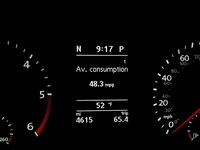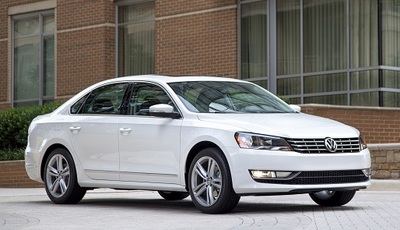2015 Volkswagen Passat TDI SE Review By Carey Russ
DRIVING DOWN THE ROAD
WITH CAREY RUSS
2015 Volkswagen Passat TDI SE
From the outside, it seems that not much has changed to Volkswagen's made-in-America-for-America Passat for model year 2015. That shouldn't be a surprise -- VW made its reputation with the Type 1 "Beetle" sedan that was visually little-changed from its inception in the late 1930s and mass production in 1945 through its final example in 2003. That made for some memorable advertisements in the late 1950s and early 1960s when that philosophy was in diametric contrast to the "change for the sake of change" annual restylings of the American auto industry.
Despite the minimal external change, that old Beetle changed and developed considerably under the skin. As has the Passat. Last year saw the old 2.5-liter five-cylinder base-model engine replaced by a new 1.8-liter turbo four. The big news for this year is a new diesel engine for the TDI model.
If your last impression of a diesel Volkswagen was a slow, smoky, and smelly Rabbit Diesel from the late 1970s, time, engineering, and technology have marched on. Better design and materials and especially electronic control of fuel injection, and turbocharging, plus exhaust after-treatments analogous to what has been applied to gasoline spark-ignition engines mean more power, an improved driving experience, and on even less fuel with lower emissions of both particulates and noxious gases.
 |
Other changes to the 2105 Passat are option package enhancements, with a Technology Package with rearview camera, satellite radio, and an upgraded audio system for S and Wolfsburg models and rain-sensing windshield wipers in SEL models. The latest 1.8T engine is found in S, Wolfsburg, SE, Sport, and SEL Premium trim. TDIs come in SE and SEL Premium levels. The flagship is the 3.6 SEL Premium, with VW's narrow-angle VR6 engine and six-speed DSG transmission.
My test TDI was an SE, so none of the leather seating, rain-sense wipers, navigation system, Fender audio, and other upgrades of the SEL. I didn't particularly miss any of those as the V-Tex leatherette works as well as leather, and the SE has all of the important functionality at a substantially lower price point. And it has the comfortable but capable chassis tuning for which VW is known and the torquey performance with excellent fuel economy that makes VW turbodiesels among the best travel machines around.
APPEARANCE: No changes? No problem! While VW uses the same basic design language for the Passat as for the smaller Jetta, there is more involved than merely pressing the "larger" button on the CAD program. Yes, the chiseled, angular lines are simple, without the baroque complexity of some competitors. I suspect that means the Passat will still look fresh years into the future. It's a car that will still look good when it's paid off.
COMFORT: Interior design follows the exterior in its simplicity. Simple can be elegant, and the shapes and contours are familiar VW motifs. It's a car, not a spaceship -- but there is plenty of space. It may be made in Tennessee, but it looks and feels German, and is not all that different from the previous Passat, just larger and roomier. Textured soft-touch synthetic material covers the upper part of the instrument panel and doors, and helps defeat glare. Here trim is textured "aluminum-look" plastic and upholstery "V-Tex" leatherette. The driver's seat is power-adjustable, including lumbar. The front passenger gets manual adjustment, but both seats offer very high levels of comfort and have three-level cushion heat. Instruments are easily visible and controls simple and intuitive, no "high tech" gimmickry here. As has been VW's standard for a long time, the steering wheel is manually adjustable for both tilt and reach. Here, it has a leather rim and controls for audio and information systems. VW was once criticized for ignoring American tastes in car interiors, as in minimal interior storage and cupholders and such. They've learned that lesson -- besides a locking glovebox, all doors have storage and drink bottle holders, there is covered space at the front of the console as well as a large console box with USB and jack inputs and a power point plus coin and toll pass holders. The spacious rear seat is, like nearly all sedans, contoured for the two outboard passengers. A high and wide central tunnel makes the center position less comfortable, just like most of the competition. The trunk is large, with a space-saver spare under its floor.
SAFETY: The Passat's passenger cabin is surrounded by a reinforced safety cage, enhanced by anti-intrusion side beams in the doors and forged steel B-pillars. Four-wheel antilock disc brakes get hydraulic Brake Assist, and the ESC electronic stability control system is standard in all models. A tire-pressure monitoring system is also standard, and the Intelligent Crash Response System automatically unlocks the doors, shuts off the fuel pump, and turns on the hazard warning lights in the event of a crash. Front, front side, and full-length side curtain airbags are standard.
RIDE AND HANDLING: It may hail from Chattanooga, TN, but the Passat's suspension design and calibration is still very much European. Meaning the fully-independent front strut, rear multilink suspension is moderately firm for good control, with properly-matched spring and damper rates for good comfort. It can be driven enthusiastically in comfort and control. And that control is important in accident avoidance, too.
PERFORMANCE: As the old saying goes, horsepower is what you brag about but torque is what you feel. And because of their design and high compression, diesels excel at torque. This one makes 236 lb-ft, peaking at a low 1750 rpm and not really dropping off at any useful engine speed. Horsepower peaks at 150, at 3500 rpm. Yes, diesels don't rev as high as spark-ignition engines, and so they can potentially last longer. Direct fuel injection is an integral part of diesel technology, as precise timing of the fuel results in the heat of compression igniting the fuel-air mixture. Turbocharging feeds in more air, for more power from less displacement compared to a naturally-aspirated engine. VW's new TDI shares little besides the cylinder spacing with its immediate predecessor. While a dual overhead cam, 16-valve design like the old TDI, this one uses each camshaft to open one intake and one exhaust valve of the two for each cylinder for improved combustion characteristics. Variable cam phasing is used to optimize power and emissions. Compared to the prior engine, the new one has reduced internal friction by around 15 percent, improving efficiency. Emissions are reduced by as much as 40 percent. The DSG transmission works well with the engine, with near-seamless shifts in automatic mode and quick shifting manually. Which is largely not a necessity given the lovely torque characteristics. And despite the Passat TDI's size, it betters many a hybrid midsize sedan on the highway with easily-attainable mileage well in excess of 40 mpg. Acceleration, at around 8.5 seconds 0-60, is good enough for all real-world use. Power does drop off at higher speeds, but that's unlikely to be a major issue in American driving.
CONCLUSIONS: As always, the Passat TDI combines comfort, space, and fuel efficiency with a typically Volkswagen fun-to-drive character.
SPECIFICATIONS
2015 Volkswagen Passat TDI SE
Base Price $ 28,840
Price As Tested $ 29,660
Engine Type DOHC 16-valve inline 4-cylinder
turbodiesel
Engine Size 2.0 liters / 120 cu. in.
Horsepower 150 @ 3500 rpm
Torque (lb-ft) 236 @ 1750 rpm
Transmission 6-speed DSG dual-clutch automated manual
Wheelbase / Length 110.4 in. / 191.6 in.
Curb Weight 3497 lbs.
Pounds Per Horsepower 23.3
Fuel Capacity 18.5 gal.
Fuel Requirement ultra-low sulfur diesel
Tires 235/45R18 94H m+s Conti ProContact
Brakes, front/rear vented disc / solid disc,
ABS and ESC standard
Suspension, front/rear independent strut /
independent multilink
Drivetrain transverse front engine,
front-wheel drive
PERFORMANCE
EPA Fuel Economy - miles per gallon
city / highway / observed 30 / 42 / 37
0 to 60 mph 8.5 sec
OPTIONS AND CHARGES
Destination Charge $ 820



